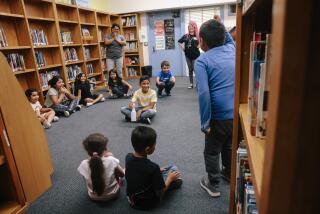BOYLE HEIGHTS : Jobs Program Aids Budding Scientists
High school junior Elena Ceja has no ordinary summer job. She wears a white lab coat and works with DNA isolated from salmon sperm, helping researchers understand genetic diseases in human teeth.
“I like learning about DNA,” said 16-year-old Elena, “and I know that it’s going to be useful for future science classes that I take.”
Elena attends Francisco Bravo Medical Magnet High School and lives in Boyle Heights with her parents and eight siblings. She is one of 12 students working this summer at the USC Health Science Campus in the minority high school student research apprentice program, which is funded by the National Institutes of Health.
Students in the program at the Center for Craniofacial Molecular Biology work full time and are paid $6.50 an hour to assist researchers with experiments. They can make more than $1,500 during the summer--a great deal for teen-agers who come from modest backgrounds.
“Some of them will make more money than their parents do,” said Dr. Charles Shuler, a USC professor of dentistry who directs the program. “It’s certainly a shock.”
The aim of the program, which Shuler helped start five years ago, is to encourage more nonwhite students to enter biomedical science, which he says is “overwhelmingly a white-male-dominated profession.” The program allows the young scientists a taste of what it’s like to be a medical researcher.
“We started this program to give the high school students the opportunity to experience cutting-edge biomedical research firsthand,” Shuler said. “These kids do real science.”
They are involved in experiments studying subjects from embryonic muscle development to digit separation in the hand. The experience sometimes changes their lives.
“I would say that the vast majority of these people have gone on to science majors in college,” Shuler said. From the original eight-student class, Shuler says, two have gone on to medical school, and most current apprentices profess interest in health science careers. Elena, for one, hopes to become a doctor.
In this year’s class, there are three African Americans, five Latinos, three Asians/Pacific Islanders and one Native American. Shuler says it’s crucial to encourage the growing nonwhite population to aspire to careers in science. The USC program is one of many similar programs at research universities nationwide.
But Shuler is concerned that such programs may not have a future given the current budget-cutting climate in Washington. Congressional members aiming to balance the budget have proposed cutting NIH’s research funding.
“These [research training] programs are in jeopardy,” Shuler said. “Training grants tend to get hit early when the government starts cracking down . . . because they don’t have a product except increased knowledge.”
If USC’s program were to disappear, scientists-in-training could lose more than plum summer jobs. They could lose a chance to explore.
Tanisia Johnson, for example, has taken time between her lab work preserving the palates of mouse embryos to look at living cancer cells through the microscope of another researcher. The disease affected the 16-year-old personally nearly four years ago, when her father died of prostate cancer.
“I’m ready to help find a cure,” Tanisia said.
The Los Alamitos High School senior now wakes up at 5 a.m. to catch a ride to work with her physiology teacher, who also is a researcher at the USC lab. Johnson said she enjoys the work because it allows her to satisfy her curiosity.
“I’ve always been interested in science,” she said. “And I wanted to know what it’s like to do research.”
More to Read
Sign up for Essential California
The most important California stories and recommendations in your inbox every morning.
You may occasionally receive promotional content from the Los Angeles Times.










